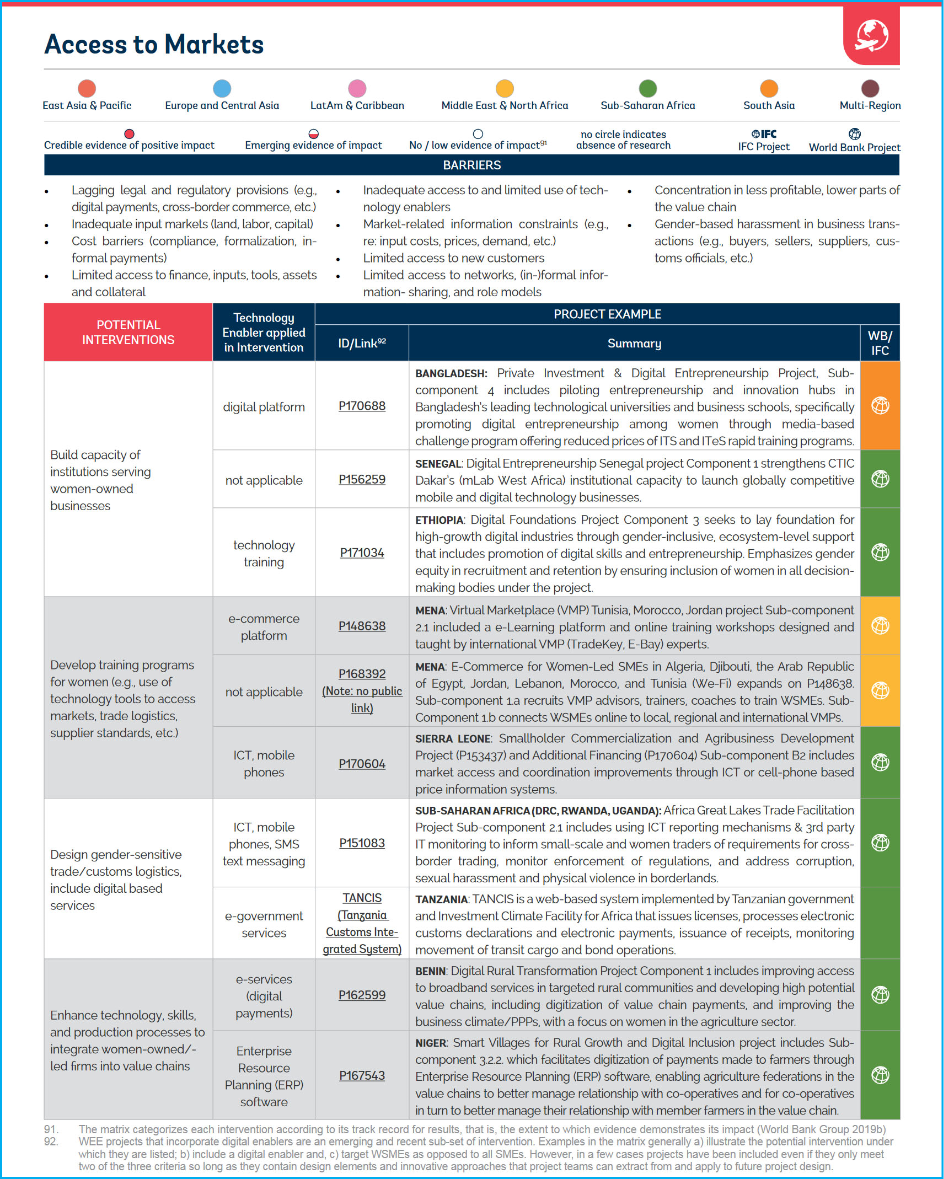From Diagnostic to Design — Putting It All Together
Building on the findings from the diagnostic, this section presents three tools that teams can use to prioritize gender-related interventions and guide project de-sign: (1) an intervention design matrix; (2) a set of criteria and “dos and don’ts” for technology use; and (3) a case study illustrating a replicable good practice example.
It is important to distinguish between the impacts of a gender-focused intervention targeted specifically toward women entrepreneurs, such as capacity building courses for female business owners or efforts to recruit women to serve as retail agents for financial service providers, and gender-neutral interventions directed toward both men and women but that are expected to have disproportionately positive impacts for women, such as regulatory reforms to enable mobile money or facilitate the use of immovable collateral.
The Intervention Design Matrix
The matrix helps teams match barriers identified during analysis with potential interventions to lower them. It also suggests digital enablers for each intervention category and provides a corresponding project example. Please see Appendix 5 for the complete matrix. The matrix is organized according to the toolkit’s four main constraint categories (legal and regulatory; access to finance; training, skills, and information; access to markets). For each category, barriers faced by women entrepreneurs are listed.
These barriers are economic and social factors that may affect the general population, business community, or women as a group and, as such, represent obstacles causing WMSME growth to stagnate, such as encumbering processes for establishing and formalizing businesses, inhibiting access to the resources needed to fuel growth, and/or restricting information and communication flows among stakeholders. It is important for project teams to use the findings from the diagnostic to determine which barriers are most critical to address in project design. The interventions proposed are drawn from WBG projects and from some non-WBG initiatives. The matrix categorizes each intervention according to its track record for results, that is, the extent to which evidence demonstrates its impact (World Bank Group 2019b):

Information presented in the matrix is based on both World Bank Group reports (World Bank Group 2019b) and input from technical experts and captures prior or ongoing project interventions. In total, in-formation for the matrix came from 275 World Bank projects, 35 IFC advisory projects, and 60 non–World Bank interventions according to three key criteria:
- The project illustrates the potential intervention.
- Women were specific beneficiaries of the project.
- The project used a digital enabler to implement its activities.
The in-depth review focused on WBG projects because the toolkit was developed by a WBG team, making complete portfolio records easily accessible, and because it is intended for use primarily by WBG project teams. The preponderance of WBG projects in this matrix thus does not indicate that the WBG has been more active in the area of women’s economic empowerment; rather, it reflects the authors’ research process. It should be noted that while the goal was to use project examples that meet all criteria, finding a precise match was not always possible. In a few cases, therefore, projects were selected that met two of the three criteria, were a close fit, and had relevant elements that could be distilled and replicated by project teams.
In addition to considering the constraint-specific barriers listed in the matrix, teams should also look at the five overarching barriers listed below. These barriers, rooted in social norms, are those most likely to affect women’s economic participation and are best addressed through design adjustments rather than specific, targeted interventions. These adjustments can help ease care burdens or improve women’s limited mobility by incorporating childcare or transportation options, and they can contribute to raising awareness of these issues and creating buy-in from males.
Five Overarching Barriers:
- Women's higher risk awareness/aversion to risk
- Gender-based violence
- Mobility challenges arising from deficient physical infrastructure and social norms
- Disproportionate care burden
- Unequal allocation of household resources
Intervention Design Matrix


